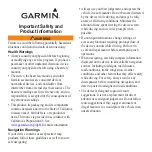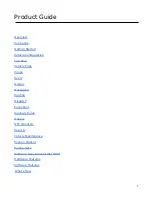
Pole mounting
If you want to pole-mount the antenna, obtain a pole of suitable
length with a 1 inch 14 TPI thread.
1
GNSS antenna
2
Pole mount adaptor
3
Mounting pole (not supplied)
1. Ensuring that the
GNSS antenna location requirements
are
met, securely attach the pole to a suitable, secure point.
2. Remove and retain the screws securing the antenna to the
pole mount adaptor, then separate these two items.
3. Screw the pole mount adaptor fully onto the pole and ensure it
is secure.
4. Feed the antenna cable through the center of the pole mount
adaptor and then down through the center of the mounting
pole.
5. Ensuring you do not trap the cable, place the antenna on
the pole mount adaptor so the screw holes are aligned, then
secure the antenna with the 3 screws removed during step 2.
Surface mounting
When surface mounting the antenna, you can route the cable
either centrally (Option A) or from the side of the antenna
(Option B).
Important:
If you are replacing a GPS antenna supplied with
an older AIS receiver or an AIS700 with an early (low) serial
number, please be aware that the mounting diameter (cutout) of
the GPS receiver has changed, from Ø44 mm to Ø60 mm.
1. Remove the 3 screws securing the antenna to its pole mount
adaptor, then remove the adaptor from the antenna.
2. Using the supplied mounting template, mark and drill the
mounting holes.
• OPTION A: If the cable is going to pass through the mounting
surface, drill a 19 mm (0.75 in.) center hole for the cable.
• OPTION B: If the cable is to be routed from the side of the
antenna (i.e. above the mounting surface), remove the piece
of plastic covering the end of the cable channel and route
the cable through the channel (1). Incorrect cable routing can
cause damage to the cable.
3. Screw the supplied mounting studs (2) into the underside of
the antenna.
4. Stick the supplied gasket (3) to the mounting surface, ensuring
that the holes on the gasket correspond with the drilled holes.
5. Route the cable as follows:
• For Option A, feed the cable down through the center hole.
• For Option B, route the cable along the cable channel.
6. Carefully place the antenna so the mounting studs pass
through the holes in the mounting surface.
7. Secure the antenna to the surface using the supplied thumb
nuts (4).
Note:
• The thumb nuts supplied with your product may differ slightly
from those shown in the illustration.
• Only use the studs and thumb nuts supplied with the antenna.
Connecting the antenna
The antenna must be connected to a compatible multifunction
display (MFD), AIS, or VHF unit.
Note:
For Ray53, Ray63, Ray73 radios, the GNSS antenna
connection can be found at the end of a captive cable
connected to the radio base unit.
1. Fully insert the antenna’s cable connector into the antenna
connector on the rear of your MFD, AIS, or VHF unit. Refer to
the note above for Ray53, Ray63, Ray73 radios.
2. Turn the locking collar clockwise until
tight
.
3. Push the protective boot over the connection on the back of
the MFD, AIS or VHF unit, and secure with a cable tie.
GA200 Installation instructions
3






















